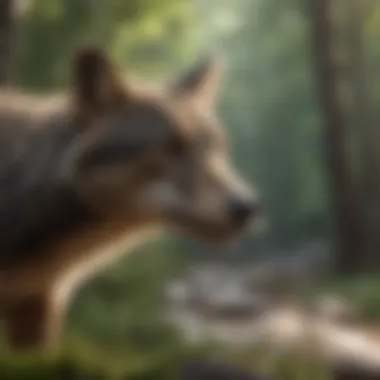Exploring National Parks in West Virginia: A Comprehensive Overview


Intro
West Virginia's national parks serve as vital ecological sanctuaries, providing a wealth of recreational opportunities and preserving a diverse array of flora and fauna. This section explores the significance of these parks, their unique features, and how they contribute to both environmental awareness and conservation efforts. The richness of the geological landscapes allows for various outdoor activities, making these parks not just beautiful but also essential for understanding our natural world.
Animal Profile
General Overview
West Virginia is home to a diverse collection of animal species. These parks provide critical habitats for wildlife, ranging from large mammals to small, elusive creatures. Species such as the black bear and white-tailed deer thrive in these regions, showcasing the parks' ecological diversity. Aside from mammals, birds, reptiles, and amphibians also populate the landscapes, each adapted to thrive in their respective environments.
Habitat and Distribution
The habitats within the national parks vary significantly. Dense forests, open fields, and riparian zones all contribute to a rich tapestry of wildlife. For example, the Monongahela National Forest features mixed hardwood forests that host diverse species like the eastern chipmunk and the red-tailed hawk. The adaptability of these animals to specific landscapes is a key factor influencing their distribution throughout the parks.
Fascinating Facts
Unique Traits and Adaptations
Many animals in West Virginia's national parks exhibit fascinating adaptations to their environments. The ability of the eastern box turtle to retract its head and limbs offers protection from predators. Similarly, the camouflage of certain species helps them blend into their surroundings, enhancing their survival.
Historical and Cultural Significance
The history of wildlife in these parks is intertwined with the cultural heritage of the region. Indigenous peoples once inhabited these lands, relying on the local fauna for sustenance. Understanding the historical context enriches the experience of visiting these parks and highlights the importance of preserving these natural habitats for future generations.
Conservation Status
Current Population Trends
Monitoring the populations of various species is crucial for conservation efforts. Some species, like the American black bear, have shown population stability due to ongoing conservation strategies. However, specific smaller species face challenges due to habitat loss and climatic changes.
Threats and Challenges
The primary threats to wildlife in West Virginia's national parks include habitat fragmentation, invasive species, and climate change. Addressing these challenges through targeted conservation policies is essential for maintaining the ecological integrity of these protected areas.
Care Tips for Pet Owners
Basic Needs and Requirements
For those considering visiting national parks with pets, understanding the basic needs of animals is crucial. Ensuring that pets are well-fed, hydrated, and comfortable can enhance the experience for both owner and pet. It is important to familiarize yourself with park regulations regarding pets, as some areas may have restrictions.
Health and Wellness Tips
Pet health is essential during any adventure. Regular check-ups and vaccinations ensure that pets remain healthy while exploring new environments. Carrying a first-aid kit for pets can also provide peace of mind during outings.
Preamble to National Parks in West Virginia
National parks serve as vital natural sanctuaries, showcasing biodiversity and unique geographies. They hold immense significance within the context of West Virginia, a state defined by its rugged mountains and sprawling flatlands. In this section, we will explore the essential qualities of national parks in West Virginia. The discussion will center around their role in conservation, recreational opportunities, and educational benefits.
Overview of West Virginia's Natural Landscape
West Virginia's natural landscape is a stunning combination of mountainous terrain, forested regions, and flowing rivers. The Appalachian Mountains dominate the state's geography, contributing to a varied ecosystem. Within these mountain ranges, lush forests and diverse vegetation flourish. The state is home to a plethora of flora and fauna, making it a key area for environmental study and preservation.
- The prominent geographical features include the Allegheny Mountains and the Monongahela National Forest.
- Rich biodiversity can be observed here, with endemic species that contribute to the ecological balance.
- This diverse environment shapes not only the ecosystem but also the recreational activities available in the region, including hiking, fishing, and nature observation.
Visitors and scholars alike can benefit from understanding this unique landscape as it forms a backdrop to the parks' conservation and educational purposes.


Role of National Parks in Conservation
National parks play a crucial role in conservation efforts across West Virginia. They protect vital habitats and species, ensuring that ecosystems remain intact. By safeguarding these natural areas, national parks help to preserve the state's ecological integrity.
- They provide a refuge for endangered species and mitigate the effects of habitat loss.
- Conservation programs and research initiatives within these parks focus on restoring damaged ecosystems and educating the public about biodiversity.
- Furthermore, parks foster community involvement in preservation efforts, encouraging both locals and tourists to engage in sustainable practices.
Key National Parks in West Virginia
The national parks of West Virginia serve as significant bastions of natural beauty and ecological diversity. These parks not only attract visitors seeking to reconnect with nature but also play a vital role in conservation efforts and the protection of unique habitats. Understanding the key national parks in West Virginia provides insight into the geological, recreational, and ecological elements that define the state's landscapes.
New River Gorge National Park
Geological Features
The geological features of New River Gorge National Park are striking and diverse. The park showcases dramatic cliffs, deep gorges, and rugged terrain. The New River itself carved out this stunning landscape, creating one of the oldest rivers in North America. The gorge walls are composed of a mix of sandstone and shale, providing a glimpse into millions of years of geological history.
This park is an enduring choice for those interested in geology because of its remarkable rock formations. The presence of fossils within some of these formations adds educational value, making it a compelling area for researchers and educators alike. However, the rugged landscape can pose challenges for accessibility, but its unique features make the effort worthwhile.
Recreational Activities
Recreational activities abound in New River Gorge. The park offers activities such as rock climbing, whitewater rafting, and hiking, making it an excellent destination for adventure enthusiasts. Rock climbing is especially popular due to the variety of routes available, catering to different skill levels.
This park’s reputation as a prime climbing destination enhances its appeal. The availability of guided tours can help beginners learn the ropes in a safe environment. However, the risk associated with some activities necessitates proper training and understanding of the natural elements involved.
Biodiversity and Ecosystems
The biodiversity present within New River Gorge is noteworthy. Various ecosystems exist, including forests, rivers, and cliffs, each supporting unique species of plants and animals. The park is home to numerous endemic species, which enrich its ecological importance.
The variety of habitats allows for a wealth of wildlife observation opportunities. This aspect is beneficial for educators studying ecology, as well as for visitors interested in wildlife photography. Nevertheless, the park faces challenges from invasive species, highlighting the need for ongoing conservation efforts.
Kanawha State Forest
Forest Management and Conservation
Kanawha State Forest exemplifies effective forest management and conservation practices. This park covers approximately 9,300 acres of mixed hardwood forest, offering visitors both recreational opportunities and environmental lessons. The management strategies implemented here focus on sustainability and preserving natural resources.
This park serves as a model for others in terms of its conservation programs and educational initiatives. Its well-maintained facilities support various activities while protecting sensitive habitats. However, balancing recreational use and forest health remains an ongoing challenge for park managers.
Hiking and Trails
The extensive hiking and trails network in Kanawha State Forest is a highlight for many visitors. With over 25 miles of trails, it caters to hikers of all skill levels. The trails weave through the forest, offering scenic views and tranquility. Each trail is well-marked, making navigation straightforward for guests.
The accessibility of these trails enhances the park's appeal, allowing for a diverse range of visitors to experience its beauty. However, some paths might exhibit wear over time, underscoring the need for regular maintenance to ensure safety and enjoyment.
Wildlife Habitat
Wildlife habitat within Kanawha State Forest is crucial for numerous species. The forest houses a range of mammals, birds, and reptiles, all benefiting from the park's diverse ecosystems. This variety supports the park's educational programming, allowing for hands-on experiences in wildlife observation.
The forest's health indicates the overall condition of the ecosystem, making it critical for conservationists. Inherent challenges exist, including human impacts on wildlife habitats, which necessitate ongoing education about responsible park use.
Blackwater Falls State Park
Waterfalls and Scenic Views
Blackwater Falls State Park is famous for its stunning waterfalls and panoramic views. The park features the breathtaking 62-foot Blackwater Falls, which is particularly striking during the autumn months when foliage creates a dramatic backdrop. The waterfall’s unique dark water, colored by the tannins from the surrounding hemlock and red spruce trees, is a notable characteristic.


The park's scenic views enhance its popularity among photographers and nature lovers alike. Well-placed viewing platforms allow visitors to safely appreciate the falls' beauty. However, accessibility can be limited during winter, when icy conditions might deter exploration.
Visitor Facilities
Visitor facilities at Blackwater Falls State Park are designed to accommodate a diverse range of guests. The park provides lodging options, picnic areas, and educational centers to enhance the visitor experience. These amenities create a welcoming environment for families and groups, encouraging longer stays.
Well-maintained facilities add to the park’s family-friendly reputation. However, crowded peak seasons may detract from the experience, underscoring the need for managing visitor numbers effectively during those times.
Environmental Education
Environmental education is a core mission at Blackwater Falls State Park. The park offers programs and workshops focusing on local ecosystems, conservation efforts, and the flora and fauna that thrive in the area. Engaging educational programs cater to schools, making it a resource for the community.
This commitment to environmental education benefits both visitors and local conservation efforts. By promoting awareness, the park fosters a culture of stewardship among guests. Nevertheless, continuous funding and support are needed to sustain these valuable educational initiatives.
Historical Context of National Parks in West Virginia
Understanding the historical context of national parks in West Virginia is crucial for appreciating their current significance. These parks reflect the rich cultural heritage, diverse ecological habitats, and long-standing efforts in conservation practices within the region. By examining the establishment of these parks and their cultural significance, one can better understand how they play a role in preserving both the environment and local history.
Establishment of the Parks
The establishment of national parks in West Virginia dates back to the early 20th century when public awareness regarding the need for environmental protection surged. Initially, efforts were motivated by the desire to protect the unique geological features and the breathtaking landscapes of the region.
A key moment was the designation of New River Gorge as a national park. The decision came in response to the logging and mining activities that threatened the natural beauty and biodiversity of the area. The park officially gained national status in 2020, representing a culmination of advocacy and local commitment towards conservation.
Beyond New River Gorge, parks like Blackwater Falls State Park were established to safeguard unique ecosystems and scenic locales. These areas not only serve as recreational spaces but also protect watersheds and preserve wildlife habitats.
Cultural Significance
The cultural significance of West Virginia's national parks is multi-dimensional. These parks are not merely spaces for recreation; they are also repositories of history that tell the stories of indigenous peoples, early settlers, and the industrial past of the region. For example, the lands within the parks were once inhabited by Native American tribes who understood the land's value and resources.
Visiting these parks today allows individuals to engage with this rich heritage through various trails and interpretive signs that provide educational insights. The parks also host events that celebrate local traditions and cultures, fostering a sense of community and pride.
National parks in West Virginia serve as a bridge between the past and the present, reminding visitors of the importance of preservation and the rich cultural stories tied to these lands.
In summary, the historical context surrounding West Virginia's national parks highlights their evolution from natural wonders to protected areas of ecological and cultural importance, thus enriching the experience of all who visit them.
Flora and Fauna of West Virginia National Parks
The flora and fauna of West Virginia national parks represent a vital aspect of these protected areas. Understanding the diversity of plant and animal life is crucial in appreciating the ecological balance that national parks strive to maintain. These natural ecosystems not only sustain wildlife but also provide numerous benefits to human communities, including tourism opportunities and educational programs focused on conservation. A well-planned approach to managing both endemic and invasive species will contribute to preserving the unique biodiversity of these parks. This section will explore two significant elements: endemic species and the challenges posed by invasive species.
Endemic Species
Endemic species are those plants and animals that are native to a specific geographic area and are not found naturally anywhere else. In West Virginia’s national parks, this concept holds particular significance. These unique species can give insight into the evolutionary processes that have shaped the region's biodiversity over time.
Some noteworthy endemic plant species in West Virginia include the West Virginia spring beauty and the West Virginia white trillium. Likewise, certain animal species, like the Cheat Mountain salamander, are exclusive to the area. The presence of these species highlights the need for conservation efforts that protect their habitats from external threats such as urban development and climate change. Endemic species often serve as indicators of ecological health, making them important for scientists and conservationists.
Invasive Species Challenges
Invasive species present a significant challenge to the ecosystems of West Virginia’s national parks. These are non-native organisms that, when introduced to a new environment, can cause disruptions to the existing ecological balance. They often outcompete local flora and fauna for resources, leading to declines in endemic populations.
Common invasive species found in West Virginia national parks include the Japanese knotweed and the emerald ash borer. The infestation of these species not only affects biodiversity but also complicates restoration efforts for native habitats. Addressing the threat of invasives requires comprehensive management strategies that may involve removal, public education, and community involvement.
"High levels of biodiversity contribute to ecological stability. However, invasive species can undermine this stability, making their management crucial in national parks."
By prioritizing the study and management of both endemic and invasive species, West Virginia’s national parks can enhance their ecological resilience. This will not only benefit wildlife but also reinforce the parks’ role as vital resources for education and conservation in the context of broader ecological frameworks.


Visitor Experience and Activities
Visiting national parks in West Virginia offers a unique blend of relaxation, adventure, and education. The experience within these protected areas can significantly enhance a person's understanding and appreciation of the natural world. This section will explore the key elements of the visitor experience, focusing on guided tours, educational programs, camping, and lodging options.
Guided Tours and Educational Programs
Guided tours provide structured opportunities for visitors to explore the parks while gaining in-depth knowledge about local history, ecology, and wildlife. These tours are often led by knowledgeable park rangers or local experts who can share insights that self-led visitors might miss. Engaging with professionals allows guests to ask questions and receive tailored information.
Educational programs frequently accompany guided tours. These programs can range from workshops on local flora and fauna to seminars on conservation efforts. Participants can increase their awareness of the pressing environmental issues affecting the parks, fostering a deeper connection with nature.
Benefits of guided tours and educational programs include:
- Personalized Learning: Visitors can tailor their experience to match personal interests, whether that is birdwatching, geology, or cultural history.
- Enhanced Safety: Experienced guides are knowledgeable about the terrain and what to avoid, ensuring visitors stay safe during their adventures.
- Community Engagement: These activities can involve local communities, offering a sense of connection to both the environment and the people who live near the parks.
Camping and Lodging Options
Camping provides an immersive experience for visitors wishing to connect more deeply with the natural settings of West Virginia. Options vary from primitive camping sites to established campgrounds with modern amenities. Each type of camping allows visitors to experience the park’s beauty overnight, listening to the sounds of nature as they sleep.
For those preferring more comfort, there are a variety of lodging options available. Facilities range from cozy cabins to more luxurious accommodations. Staying within or near the park can provide quick access to various activities and attractions without the hassle of long travel. Common lodging options include:
- Cabins: Ideal for families or groups, offering a balance of nature and convenience.
- Lodges: Often featuring dining options and guided tours right outside the door.
- Campsites: Budget-friendly and perfect for those seeking a deeper connection with nature.
In West Virginia’s national parks, visitors can tailor their stay to create an unforgettable experience. Whether partaking in educational programs or enjoying a night under the stars, each experience contributes to the overall appreciation of these vital natural resources.
Engagement with the parks through varied activities and experiences cultivates a deeper understanding of nature and its conservation.
Environmental Impact and Conservation Strategies
Environmental impact and conservation strategies are crucial for maintaining the ecological balance in West Virginia's national parks. These protected areas face various challenges, including climate change, invasive species, and human activity. Understanding these factors is essential for fostering sustainable practices that preserve the natural beauty and biodiversity of these landscapes.
Sustainable Tourism Practices
Sustainable tourism is a key approach in minimizing the adverse effects that visitors can have on the environment. This practice emphasizes responsible travel to natural areas, promoting conservation while also providing a rich experience for tourists. Parks like New River Gorge National Park implement several initiatives to promote sustainability.
For instance:
- Leave No Trace Principles: Visitors are educated on best practices to minimize their impact, such as proper waste disposal, staying on trails, and respecting wildlife.
- Eco-Friendly Accommodations: Local businesses are encouraged to adopt sustainable practices, such as reducing energy use and utilizing eco-friendly materials.
- Wildlife Protection Programs: Initiatives focus on ensuring that tourism does not disrupt the natural behaviors and habitats of local species.
By fostering these sustainable tourism practices, national parks not only protect their ecosystems but also create an educated and environmentally conscious visitor base.
Community Involvement and Education
Community involvement plays a significant role in conservation efforts within West Virginia's national parks. Engaging local residents in education and conservation initiatives fosters a sense of ownership and responsibility. Moreover, well-informed communities can become advocates for the protection of their local environment.
Parks often host events that encourage local participation, such as:
- Workshops and Seminars: These events educate the public on the importance of biodiversity and the role of national parks in conservation.
- Volunteer Programs: Residents can volunteer for trail maintenance, clean-up days, and habitat restoration projects, providing hands-on experience.
- Collaboration with Schools: Local educational institutions partner with park services to integrate environmental education into their curriculums.
These community-focused efforts ensure that conservation strategies are shared and supported, leading to a more sustainable future for the parks and their surrounding regions.
The preservation of national parks in West Virginia is not only a responsibility of park management but also of the communities that surround these natural wonders. Their involvement is crucial for successful conservation practices.
The End
Recap of Importance
The national parks in West Virginia stand as vital havens of biodiversity and natural beauty. These parks provide essential ecosystem services, support wildlife habitats, and offer recreational opportunities for visitors. Recognizing their importance helps us understand the interconnectedness of human activity and ecological health. By engaging with these areas, we foster an appreciation for nature that encourages conservation efforts. From geological formations in the New River Gorge to the diverse ecosystems in Kanawha State Forest, each park contributes significantly to the overall ecological tapestry of West Virginia.
Future of National Parks in West Virginia
The future of national parks in West Virginia is promising but requires diligent attention. Planning and management strategies will need to adapt to ongoing environmental changes, including climate change and invasive species. Sustained investment in park infrastructure and visitor services will be vital to enhance the experience for all guests. Moreover, strengthening partnerships with local communities can foster stewardship and promote sustainable tourism practices.
The role of education is also crucial. Educational programs can raise awareness about the ecological importance of these parks. Collaboration among educators, wildlife biologists, and park management can drive initiatives that engage the public and foster a deeper understanding of conservation. Protecting these parks safeguards not only their intrinsic value but also the cultural heritage and history they embody for future generations.















